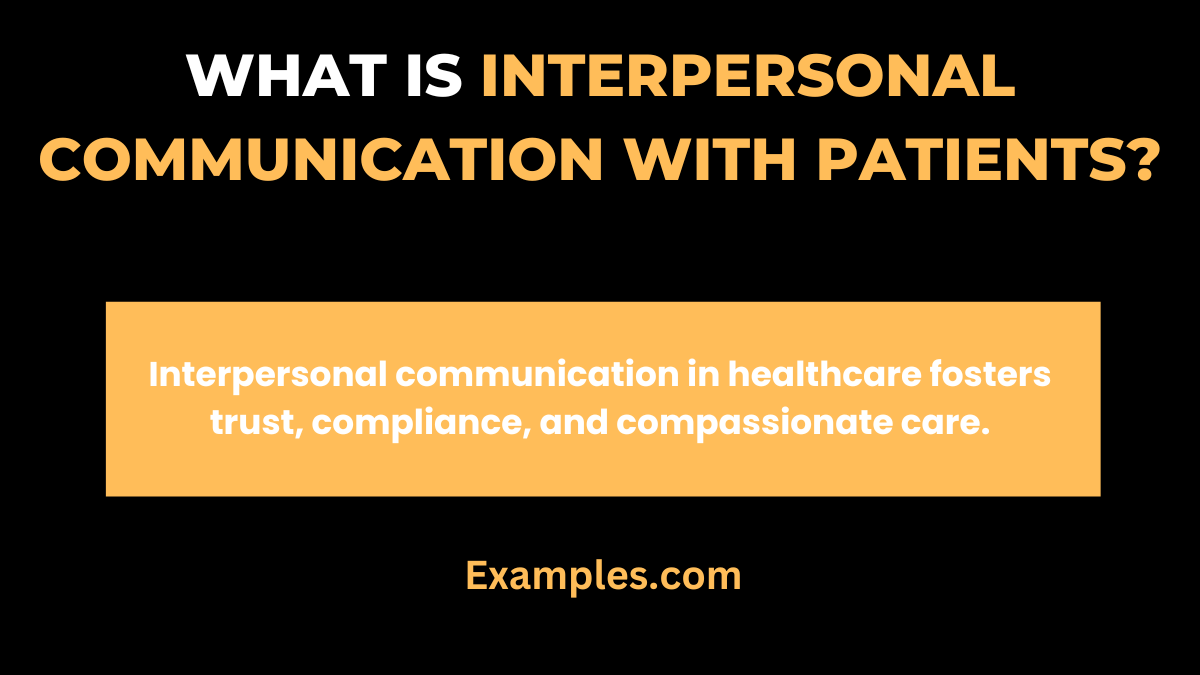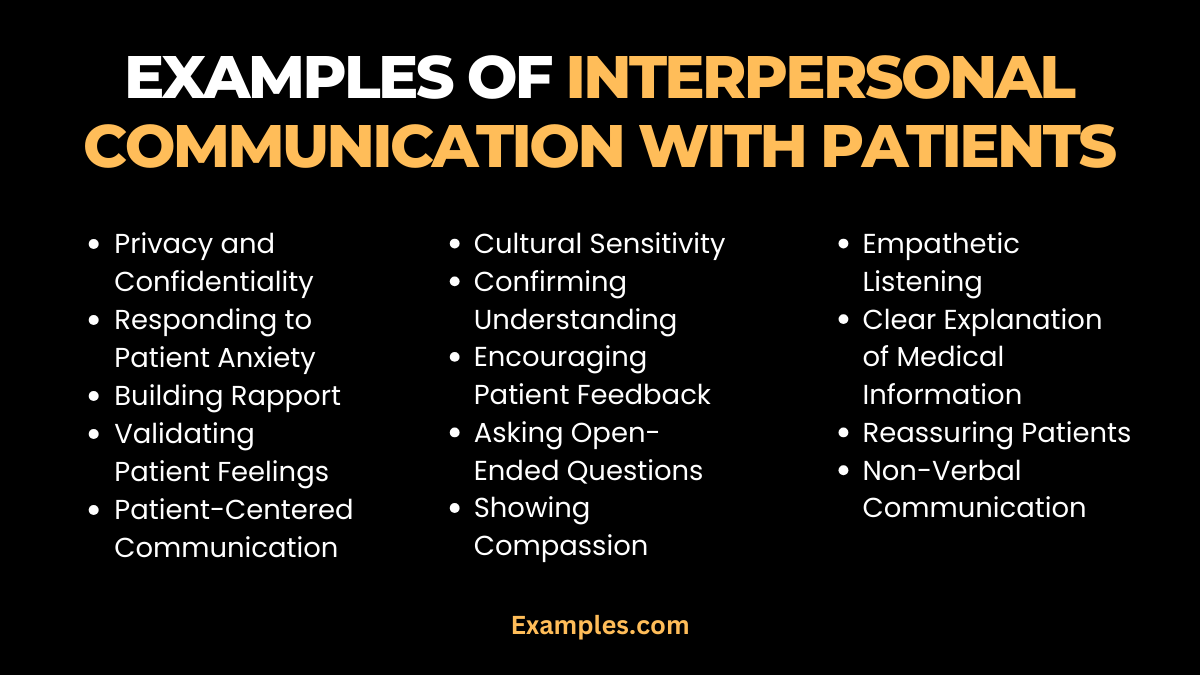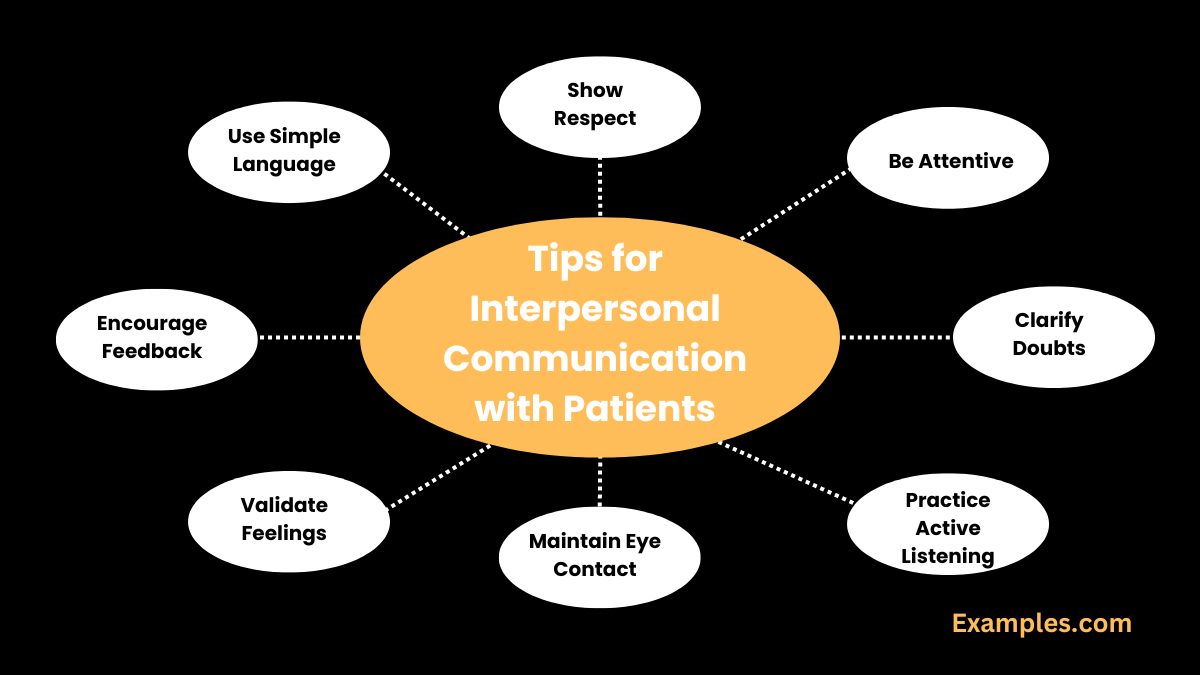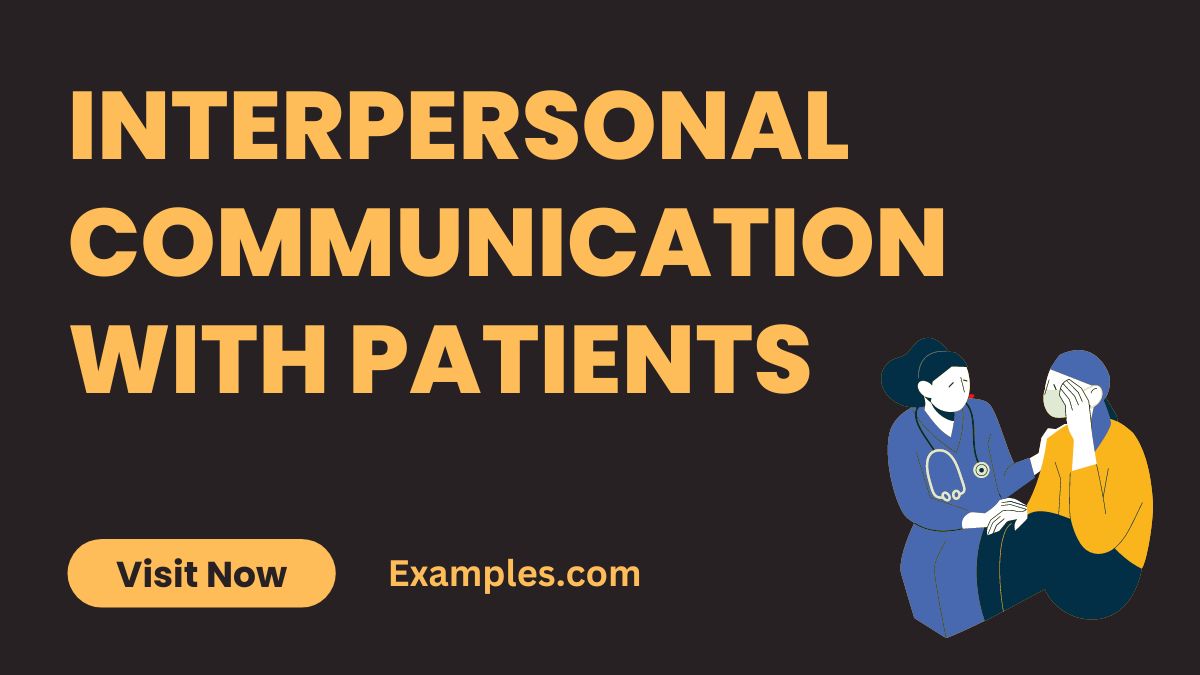Interpersonal Communication with Patients
Delve into the nuances of interpersonal communication with patients, a crucial aspect of healthcare. This guide, enriched with practical communication examples, provides insights into how healthcare professionals can effectively interact with patients. Emphasizing empathy, clarity, and active listening, it’s an invaluable resource for enhancing patient care. Understanding the unique communication needs of patients is vital for building trust, ensuring understanding, and providing high-quality care. These examples demonstrate how to apply interpersonal skills in real-world healthcare scenarios, making every patient interaction more meaningful and effective.
What is Interpersonal Communication with Patients?

Interpersonal communication with patients refers to the way healthcare professionals interact with their patients. It involves not just the exchange of information about health and treatment but also encompasses understanding the patient’s emotional and psychological needs. Effective interpersonal communication is key to building trust, ensuring patient compliance, and providing compassionate care.
20 Examples of Interpersonal Communication with Patients

- Empathetic Listening: Understanding patients’ concerns and feelings.
Example: “I hear that this has been a stressful time for you. Let’s work through this together.” - Clear Explanation of Medical Information: Conveying health information in an understandable way.
Example: “I’ll explain your treatment options in simple terms so you can make an informed decision.” - Reassuring Patients: Offering comfort and reassurance in stressful situations.
Example: “We’re here to take the best care of you, and you’re in safe hands.” - Adapting to Patient’s Communication Style: Tailoring communication to suit individual patient needs.
Example: “I noticed you prefer detailed explanations, so I’ll provide more specifics.” - Non-Verbal Communication: Using body language to convey empathy and understanding.
Example: “My open posture and eye contact show my patients that I’m fully engaged.” - Asking Open-Ended Questions: Encouraging patients to share more about their experiences.
Example: “What concerns do you have about your treatment?” - Patient Education: Educating patients about their health in a comprehensible way.
Example: “Let me explain how this medication works and how it will help you.”

- Cultural Sensitivity: Being aware of and respecting cultural differences in communication.
Example: “I respect your cultural practices and will consider them in your care plan.” - Confirming Understanding: Making sure patients understand their health situation and care plan.
Example: “Can you tell me what you understand about the procedure?” - Encouraging Patient Feedback: Inviting patients to express their thoughts and concerns.
Example: “Do you have any questions or worries about what we discussed?” - Dealing with Difficult Conversations: Handling sensitive topics with care and professionalism.
Example: “I understand this news is hard. Let’s discuss what it means for you.” - Showing Compassion: Demonstrating genuine care and concern.
Example: “I’m here to support you through every step of your treatment.” - Effective Use of Tone and Voice: Using a comforting and reassuring voice.
Example: “My calm tone helps put patients at ease during consultations.” - Privacy and Confidentiality: Maintaining the privacy of patient information.
Example: “I assure you, our conversation remains confidential.” - Responding to Patient Anxiety: Addressing and alleviating patients’ fears.
Example: “Let’s talk about what’s worrying you so I can help alleviate your concerns.” - Building Rapport: Establishing a trusting and friendly relationship.
Example: “I take time to get to know my patients to build a trusting rapport.” - Validating Patient Feelings: Acknowledging and validating patients’ emotions.
Example: “It’s completely normal to feel anxious about this procedure.” - Patient-Centered Communication: Focusing on the patient’s needs and perspectives.
Example: “Tell me what’s most important to you about your care.”

- Collaborative Decision Making: Involving patients in their care decisions.
Example: “Let’s decide together what the best course of action is for you.” - Consistent Follow-Up: Maintaining communication to monitor patient progress.
Example: “I’ll check in with you regularly to see how you’re doing with the treatment.”
Elements of Interpersonal Communication with Patients
- Active Listening: Essential in understanding patient concerns. Involves attentively listening to their words and the emotions behind them, ensuring patients feel heard and valued.
- Empathy: Demonstrating empathy involves acknowledging and respecting a patient’s feelings and experiences, vital in building trust and rapport.
- Clear Explanation: Healthcare providers must communicate medical information in a way that is easily understood, avoiding medical jargon to ensure patient comprehension.
- Non-Verbal Cues: Body language, eye contact, and facial expressions play a significant role in conveying care and attention to patients.
- Patience: Exhibiting patience, especially when dealing with anxious or confused patients, is key to effective communication.
- Cultural Sensitivity: Understanding and respecting diverse cultural backgrounds and beliefs of patients are crucial for effective communication.
- Feedback Encouragement: Encouraging patients to ask questions and give feedback fosters a two-way communication channel.
- Confidentiality: Maintaining patient confidentiality is a fundamental element, ensuring privacy and trust in the patient-provider relationship.
Importance of Interpersonal Communication with Patients
- Building Trust: Effective communication helps in building trust, a cornerstone of the patient-care provider relationship.
- Enhancing Patient Satisfaction: Good communication leads to higher patient satisfaction, as patients feel valued and understood.
- Improving Health Outcomes: Clear and empathetic communication can lead to better health outcomes, as patients are more likely to follow medical advice and treatment plans.
- Reducing Misunderstandings: Effective communication minimizes the risk of misunderstandings regarding diagnoses and treatment options.
- Encouraging Patient Participation: Good communication encourages patients to be active participants in their care, leading to more informed decisions.
- Alleviating Anxiety: Clear and compassionate communication can help reduce patient anxiety, especially in stressful medical situations.
- Promoting Adherence to Treatment: Patients are more likely to adhere to treatment plans when they understand and agree with the proposed care.
- Fostering Continuity of Care: Effective communication ensures a seamless flow of information, crucial for continuity of care especially in team-based healthcare settings.
Tips for Interpersonal Communication with Patients

- Use Simple Language: Avoid medical jargon to ensure patients understand their health conditions and treatments.
- Show Respect: Always address patients respectfully, considering their preferences and dignity.
- Be Attentive: Give patients your full attention during consultations, making them feel valued.
- Clarify Doubts: Encourage patients to ask questions and clarify any doubts they may have.
- Practice Active Listening: Listen to understand, not just to respond, showing patients that their concerns are being heard.
- Maintain Eye Contact: Eye contact shows you are engaged and interested in what the patient is saying.
- Validate Feelings: Acknowledge patients’ emotions, validating their feelings regarding their health concerns.
- Be Mindful of Body Language: Ensure your body language conveys openness and empathy.
- Encourage Feedback: Ask for feedback to understand if the patient has grasped the information shared.
- Follow Up: Follow up with patients, especially regarding test results or treatment responses, to demonstrate ongoing care and commitment.
In conclusion, this guide on Interpersonal Communication with Patients underscores the significance of empathetic, clear, and effective communication in healthcare. It offers valuable insights and practical tips for healthcare professionals to enhance their interaction with patients, fostering trust, understanding, and improved health outcomes. This comprehensive guide serves as an essential resource for anyone involved in patient care, emphasizing the pivotal role of communication in the healthcare setting.



